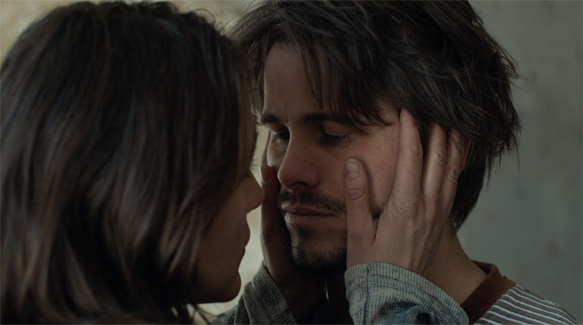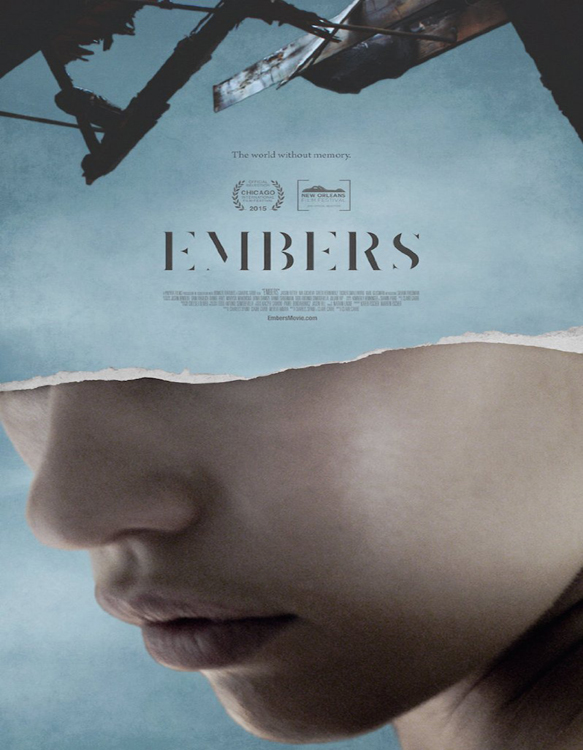What would you do if you could not remember who you were? If you woke up in an unfamiliar place next to a complete stranger. What if everyone in the world suffered from the same malady? Initially making its US premiere on October 16, 2016 at the Chicago International Film Festival, Embers presents this scenario in a hauntingly beautiful way. Co-written by Charles Spano and Claire Carré, the film has since followed the film festival circuit across the world, and on August 2nd, hit Video on Demand via The Orchard.
- Still from Embers
The film opens upon a couple awakening in a deserted house. No information is given regarding who they are or their relationship; it is just a many and a woman (played by Jason Ritter: Gravity Falls TV series, Parenthood TV series and Iva Gocheva: Sneakers 2011, Charlie 2007) waking up under the same blanket on a ratty old mattress. They discover they are wearing identical fabric “bracelets,” and deduce they were meant to stay together. They do not know how they got there, or even where “there” is. Their journey of discovering each other and their world plays out every day. They give each other names, which are soon forgotten, but fall in love anyway. They are split up by their malady, but in the end, true love will find its match. A series of interwoven stories, each exploring how people might interact when they have no collective or personal pasts, with the exception of one, none of the film’s characters are given permanent names. They are pointless since nobody would remember them, not even the people themselves.
Early on, the audience is introduced to two important characters, one for his words and the other for his actions; Guardian (Matthew Goulish: Live Transmission 2001) and Boy (Silvan Friedman: The Dawn 2014, Cotton Candy 2015). When they first meet, Friedman, seemingly oblivious to his slim chances for survival alone in this desolate landscape, is dancing in child-like joy of the world around him. Goulish comes upon him and tells him, “I’ll look out for you.” Goulish gives the boy a watch, and in an attempt to explain what it is used for, begins repeating a central theme to the film, “And now we’re here,” then forgets all about the boy. The thought, “and now we’re here,” is all any of this world’s inhabitants can count on.
Goulish’s role is short-lived as another character, the aptly named Chaos (Karl Glusman: No. 6 TV series, Ratter 2015), takes what he needs to survive without thought to those who might stand in the way of survival. Glusman’s character portrays the more animalistic traits of humanity when not governed by law or conscience.; his acts are barbaric and violent. But even this brutish behavior is suspended when confronted by natural beauty. Glusman attacks a nameless woman – who has fled immediately upon seeing Chaos, showing another basic human trait, fear of the unknown, when he spots a wild horse in a courtyard. He stops chasing the woman and gazes at it. At one point, Glusman is attacked in a horrendous act of brutality, and when confronted by the decision to end it all, even that memory disappears and he returns to his natural state of anarchy.
- Still from Embers
Friedman’s Boy character has the most interaction with those in the outside world. Throughout the film, Friedman never speaks – perhaps he has forgotten how due to his young age. In addition to his time with Guardian, he meets a girl in a long white dress (Dominique Swain: Lolita 1997, Fatal Instinct 2014). She takes him into a fantasy home filled with toys and stuffed animals, and although she promises to take care of him, like all others in the film, he has forgotten and must make his way again. Regardless of where he goes, he seems to be happy and unfrightened, taking joy in everything he sees. Eventually he meets the only character who seems to know something has happened and is trying to make sense of it.
Teacher (Tucker Smallwood: The Cotton Club 1984, Evan Almighty 2007) lives alone on a farm where he has left himself notes on simple tasks and studies books about memory. His property is lined with ropes so that he does not forget where he was going or how to get back to his home. He is really the only one who has learned to cope; even if he must relearn those lessons every day. Sets were all real locations chosen to show the decay of a world where nobody is maintaining the man-made infrastructure we rely on for modern society. The producers shot the film in three sections over three seasons – in Gary, Indiana in April, in Upstate New York in July, and in Lodz, Poland in November.
When the writers were asked about their inspiration for the film, Spano stated, “When Claire and I started this project, we knew that we wanted to make a movie dealing with memory, that was really the starting off point.” Triple-threat Writer/Director/Editor, Claire Carré said, “Embers is my first film, so I was trying to think about what is unique to me and I kept coming back to my memory. Because even with experiences that I’ve shared, how my brain remembers them will be different, and what aspects I remember and what I forget will be unique. So then I started to think, if memory is such an important part of who I am, who would I be without it?”
The virus they created for the world has the literal effect of “out of sight-out of mind.” When one of her characters is distracted or falls asleep, those short-term memories are gone. These include personal relationships formed that day and their immediate environments. The collective amnesia can be heartbreaking or a blessing. The only permanently named character, Miranda (Greta Fernández: Fiction 2006, Truman 2015) lives in an underground bunker with her father (Roberto Cots: Sophia TV series, Grand Hotel TV series). Cots has built their shelter early on in the pandemic, and through his talks with his daughter, the audience learns most of what they know about the outbreak nine years earlier.
- Still from Embers
In stark contrast to the broken and decaying world on the outside, the habitat he has created for them is modern and fully automated. They have complete memory of what happened and who they are. Cots tries to convince his daughter that this life is better than being someone on the outside, with no recollection of their families, friends, and how the world was. Fernández looks at photos and listens to music, all man-made technology created to preserve memory, none of which is available to those outside. Ultimately, Fernández demands freedom from her father. Liberation from not only being the only other inhabitant of the bunker, but of the memories of those things lost to them forever.
Throughout Embers, characters stop whatever they are doing and stare at the world around them. Each time one of them sees something inherently beautiful; the horse, sunshine, even their own reflections, they are seeing it for the very first time and are amazed. The ways the survivors adapt are believable and well portrayed. The new-found fascination with everything, and everyone around them, the animalistic brutality, the attempt to learn and cope with their limitations, contrasted with the father who had the ability to save his daughter from that fate and have her decide she would rather live in ignorant freedom than locked in the cage.
In Embers, as in life, we are left with only the wisps of the memories that remind us of who we are, where we have been, who we love. All that is really left are the embers. For this reason, CrypticRock gives Embers 4.5 out of 5 stars.
- The Orchard









This is a strangely beautiful movie set around the decay of the man-made world. The performances are excellent. My favorite actor, Jason Ritter is amazing, as usual.